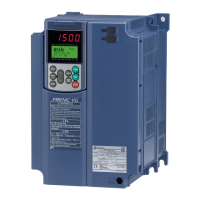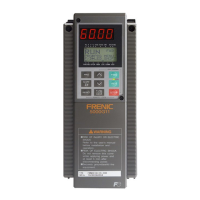6-18
Possible Causes What to Check and Suggested Measures
(4) The rated capacity of the motor
was significantly different from
that of the inverter.
Check whether the rated capacity of the motor is three or more ranks lower, or two
or more ranks higher than that of the inverter.
Î Replace the inverter with one with an appropriate capacity.
Î Manually specify the values for the motor parameters P06*, P07*, and P08*.
Î Disable both auto-tuning and auto-torque boost (set data of F37* to "1").
(5) The motor was a special type
such as a high-speed motor.
Î Disable both auto-tuning and auto-torque boost (set data of F37* to "1").
(6) A tuning operation involving
motor rotation (P04* = 2 or 3)
was attempted while the brake
was applied to the motor.
Î Specify the tuning that does not involve the motor rotation (P04* = 1).
Î Release the brake before tuning that involves the motor rotation (P04* = 2 or 3).
For details of tuning errors, refer to Chapter 4, Section 4.1.7 "Function code basic settings and tuning < 2 >, Tuning
errors."
Preparation before running the motor for a test – Setting function code data."
[ 25 ]
er8
RS-485 communications error (COM port 1)
erp
RS-485 communications error (COM port 2)
Problem A communications error occurred during RS-485 communications.
Possible Causes What to Check and Suggested Measures
(1) Communications conditions of
the inverter do not match that
of the host equipment.
Compare the settings of the y codes (y01 to y10, y11 to y20) with those of the host
equipment.
Î Correct any settings that differ.
(2) Even though no-response error
detection time (y08, y18) has
been set, communications is
not performed within the
specified cycle.
Check the host equipment.
Î Change the settings of host equipment software or disable the no-response error
detection (y08, y18 = 0).
(3) The host equipment did not
operate due to defective
software, settings, or defective
hardware.
Check the host equipment (e.g., PLCs and personal computers).
Î Remove the cause of the equipment error.
(4) The RS-485 converter did not
operate due to incorrect
connections and settings, or
defective hardware.
Check the RS-485 converter (e.g., check for poor contact).
Î Change the various RS-485 converter settings, reconnect the wires, or replace
hardware with recommended devices as appropriate.
(5) Broken communications cable
or poor contact.
Check the continuity of the cables, contacts and connections.
Î Replace the cable.
(6) Inverter affected by strong
electrical noise.
Check if appropriate noise control measures have been implemented (e.g., correct
grounding and routing of communications cables and main circuit wires).
Î Implement noise control measures.
Î Implement noise reduction measures on the host side.
Î Replace the RS-485 converter with a recommended insulated one.
(7) Terminating resistor not
properly configured.
Check that the inverter serves as a terminating device in the network.
Î Configure the terminating resistor switch(es) (SW2/SW3) for RS-485
communication correctly. (That is, turn the switch(es) to ON.)
[ 26 ]
erf
Data saving error during undervoltage
Problem The inverter failed to save data such as the frequency commands and PID commands (which are specified through
the keypad), or the output frequencies modified by the UP/DOWN terminal commands when the power was turned
OFF.
Possible Causes What to Check and Suggested Measures
(1) During data saving performed
when the power was turned
OFF, the voltage fed to the
control PCB dropped in an
abnormally short period due to
the rapid discharge of the DC
link bus.
Check how long it takes for the DC link bus voltage to drop to the preset voltage
when the power is turned OFF.
Î Remove whatever is causing the rapid discharge of the DC link bus voltage.
After pressing the
key and releasing the alarm, return the data of the relevant
function codes (such as the frequency commands and PID commands (specified
through the keypad) or the output frequencies modified by the UP/DOWN
terminal commands) back to the original values and then restart the operation.

